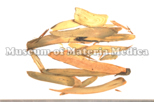Lonicera Leaf and Stem

|
TMPW No.:5673 |
| Synonym | |
| Latin name | Lonicerae Folium cum Caulis |
| Botanical source: Family name | Caprifoliaceae |
| Botanical source: Plant name | Lonicera japonica Thunberg (IPNI:148850-1) |
| Part used | Leaves and stems |
| Empirical criteria for quality selection | Good one is fresh and bright green. (NI) The one produced in Giangsu Prov. is the best quality. (TN) |
| Constituents | Flavones & Flavonols: Lonicerin (= Luteolinrhamnoglucoside) Tannins: Tannin |
| Pharmacological effects | Increasing in blood sugar. |
| Indications | As an antifebrile, antidote, diuretic and antiinflammatory, it is applied to treat swelling, hemorrhoids, gonorrhea, oliguria and poisoning of toadstool, in folk. The concentrated decoction may be used for swelling and hemorrhoids. It is also applied for muscle and bone pain. |
| Diseases | Pyogenic dermatosis, Swelling and pain of the throat, Diarrhea, Hematochezia, Fever, Rash, Chill, Swelling and pain of joint |
| Formulas | shikonboreito , jizusoippo , jizusoippokyodaio |
| Meridian tropism | Lung, Heart, Stomach |
| Property | Cold |
| Flavor | Sweet |
| Classification in "Shen-non Ben-cao Jing" | Superior |
| TCM: Classification | Antipyretics |
| TCM: Medicinal effects | To remove toxic heat, and to dispel wind from the channels and collaterals. Used for epidemic febrile disease, acute dysentery, carbuncles, sores, acute arthritis with redness, swelling and pain of the joint. |
| Remarks | Listed in the Japanese Pharmacopoeia 18th ed. |
| References | NI: N. Isshiki, Methods of Quality Evaluation and Preparation of Wakan-yaku, Tohodo Shoten, Tokyo, 1987. TN: T. Namba & Y. Tsuda ed., Outline of Pharmacognosy, a Textbook, 3rd ed., Nankodo Co., Ltd., Tokyo, 1998. |
